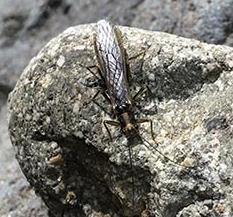Stream biological monitoring
We collect biological data from stream sites around the state, evaluating multiple aquatic communities to assess river and stream health. Because stream-dwelling organisms respond to changes in the physical and chemical environment, the collection of organisms in a stream reach provides a comprehensive indication of the conditions experienced at a particular site.
We also collect data on habitat, and on chemical and physical parameters, to measure the response of biological communities to a variety of stressors.
Four studies with one goal
Our goal is to obtain estimates of biological health in our state's rivers and streams and to evaluate how conditions change through time, in the face of climate change and growing human influence. Armed with this information, we can focus on ways to protect and improve the condition of Washington's running waters. The four stream habitat studies, Watershed Health, Water Quality Improvement Effectiveness, Ambient Biological, and Status & Trends Sentinel monitoring, are described more fully below.
Biological models evaluate macroinvertebrate communities
Hesperoperla pacifica - Golden stonefly
We've conducted biological monitoring at a limited number of sites since the early 1990s. Starting in 2009, we intensified efforts to assess stream habitat conditions and biological integrity throughout the state.
Data are collected from sites ranging from targeted sites with relatively little human influence, also called "minimally impacted" or "reference" sites, to randomly selected sites from around the state.
While each study is designed to answer specific questions, each uses the same protocols for collecting data. Because data are collected in a consistent manner, the data can be used to help us answer two primary questions:
- What is the state of biological conditions in streams and rivers throughout Washington?
- Are things getting better or worse through time?
We can begin to answer these questions with bioassessment models evaluating stream macroinvertebrate communities, most notably the benthic index of biological integrity (B-IBI), a useful tool for assessing streams in the Puget Sound basin.
Puget Sound Stream Benthos has more information on this tool. Additionally, bioassessment models are also being developed for periphyton (attached algae) communities.
Biological data
Data for raw taxa counts, as well as habitat metrics and various water chemistry and physical parameters, are contained in the Environmental Information Management (EIM) database. Four individual studies employ consistent methodologies for collecting data. Individual study datasets are linked in study details, below.
Details and data for the studies
Click each tab below to learn more and to reach datasets.
We currently sample over 100 targeted reference sites throughout Washington on a rotating basis. Each site is sampled approximately every 2-3 years. These sites help us understand what conditions are like at sites with minimal human impacts. We collect data for macroinvertebrate and periphyton communities, many measures of physical habitat, as well as various other chemical and physical parameters.
Data — EIM Study ID = WHM_BIO has results for Ambient Biological Monitoring.
We annually sample 16 targeted reference sites throughout Washington as baselines to spot trends. These sites also help us understand what conditions are like at sites with minimal human impacts. We collect data for fish, macroinvertebrate and periphyton communities, many measures of physical habitat, as well as various other chemical and physical parameters.
Data — EIM Study ID = WHM_SEN has results for status and trends sentinel-site monitoring.
We randomly sampled almost 500 sites as part of the Watershed Health Monitoring study to provide a spatially balanced, unbiased estimate of the biological health of the state's streams and rivers. Each summer, 50 sites are sampled in one of Washington's eight Salmon Recovery Regions. Data include those for fish, macroinvertebrate and periphyton communities, many measures of physical habitat, as well as various other chemical and physical parameters.
Data — EIM Study ID = WHM_WAM0 has results for Watershed Health Monitoring.
As part of Water Quality Improvement Effectiveness Monitoring, targeted studies around the state evaluate the effectiveness of various restoration activities. We collect data for macroinvertebrate and periphyton communities and many measures of physical habitat, as well as various other chemical and physical parameters.
Data — EIM Study ID = WHM_EFF has results for effectiveness monitoring.
Related links
Contact information
Chad Larson
Ambient Biological Monitoring Lead
chad.larson@ecy.wa.gov
564-669-1771


